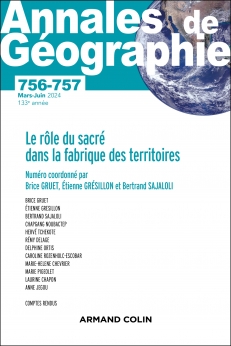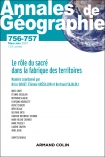
ANNALES DE GÉOGRAPHIE N°756-757 (2-3/2024)
Pour acheter ce numéro, contactez-nous
Recevez les numéros de l'année en cours et accédez à l'intégralité des articles en ligne.
Nos années 2010-2020 nous ramènent aux années 1970-1980 des écoféministes, des sorcières et du sacré : Starhawk, sorcière écoféministe californienne, incarne cette traversée transatlantique des époques. Au-delà des critiques, comment situer et lire sa pensée en géographie, l’analyser au regard des natures sacrées et de leurs implications territoriales, pour nourrir une réflexion paradigmatique en géographie culturelle de l’environnement ? Starhawk articule dans une pensée originale nature sacrée, magie et empowerment horizontal. Créatrice d’une earthbased spirituality, elle honore une Déesse immanente en chaque être vivant. En tant qu’activiste, son sacré est ce pour quoi nous sommes prêts à faire des sacrifices, devenant politique. Permacultrice, elle observe son « territoire-milieu de vie » et le ritualise plutôt qu’elle n’y laisse son empreinte anthropique, dessinant une territorialité alternative. Les sorcières écoféministes se situent géographiquement, au travers d’une éthique écocentrée, dans leurs territoires-milieux de vie pour défendre ce qui leur est sacré : la perpétuation de la vie sur la planète. Ce Reclaim écoféministe cherche donc à retisser les liens du vivant (humain.es inclus) qui avaient été séparé.es, dans une médiation sacrale – représentée par le territoire lui-même – et une ontologie relationnelle pour un autre art d’habiter.
Our 10-20’s bring us back the 70-80’s years of feminism, witches and sacred : Starhawk, as an ecofeminist and Californian witch, embodies that travel in ages across the Atlantic. Beyond the criticisms, how can we situate and read her thought in geography, analyzing it with regard to sacred natures and their territorial implications, to nourish a paradigmatic reflection in the cultural geography of the environment ? Starhawk’s original thinking articulates sacred nature, magic and horizontal empowerment. As a creator of an earth-based spirituality, she honors an immanent Goddess in every living. As an activist, her sacred is what we are willing to sacrifice for, and becomes political. During political mobilizations, streets and prison become spaces for ritualization. Permaculture designer, she watches and ritualizes her “territory-milieu of living” shared with neighbors, in a light anthropic planning, drawing an alternative territoriality. Ecofeminist witches situate themselves geographically, through an ecocentric ethic, in their “territories-milieus of living” to defend what is sacred to them : the perpetuation of life on the planet. This ecofeminist Reclaim thus seeks to reweave the links between living beings (human beings included) that had been separated, in a sacred mediation — represented by the territory itself — and a relational ontology for another art of living.

